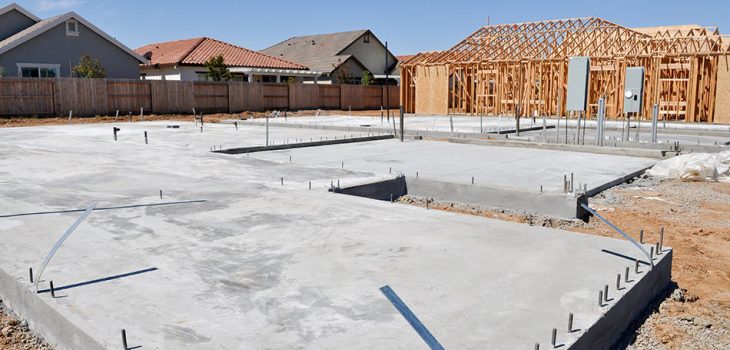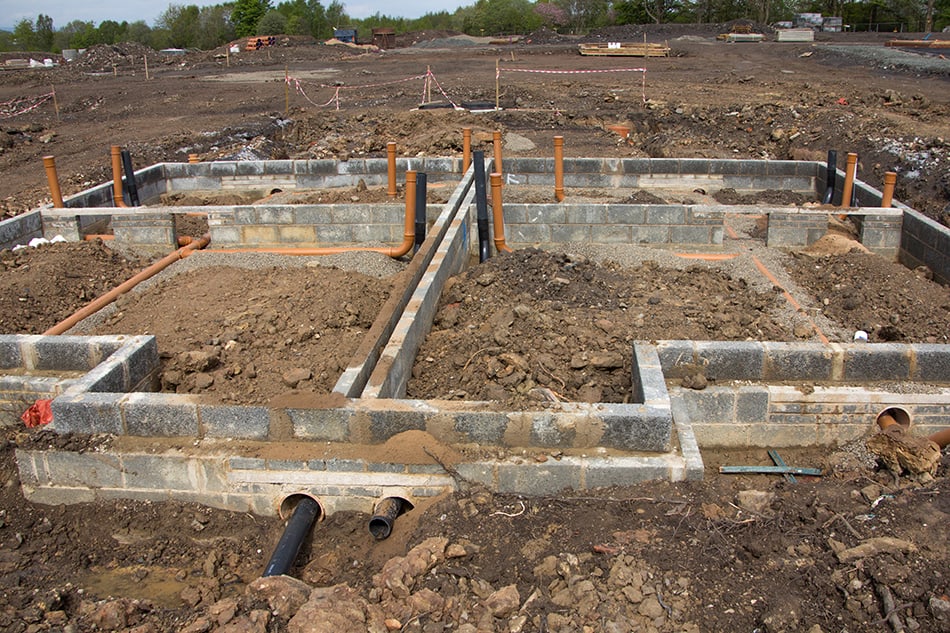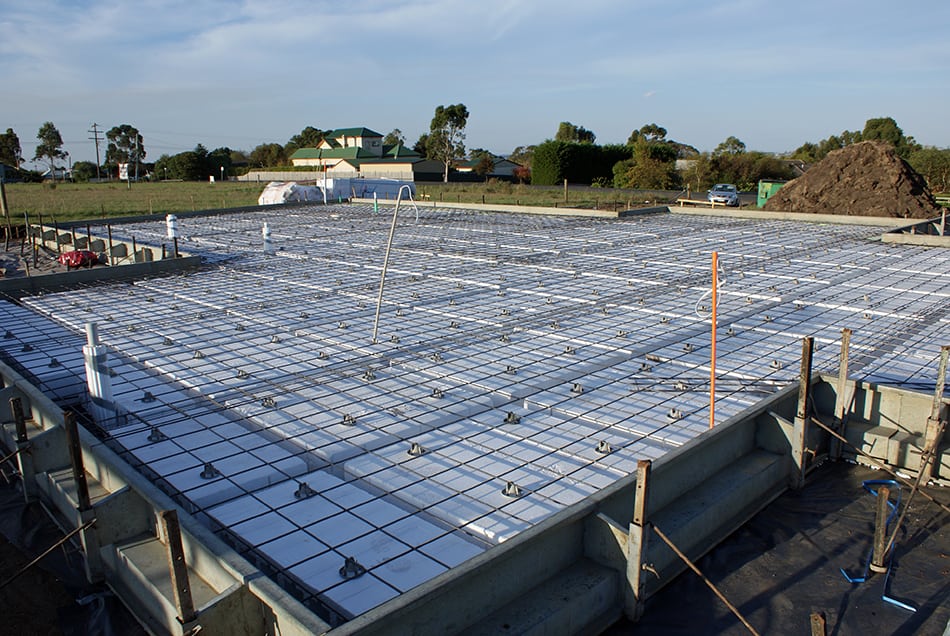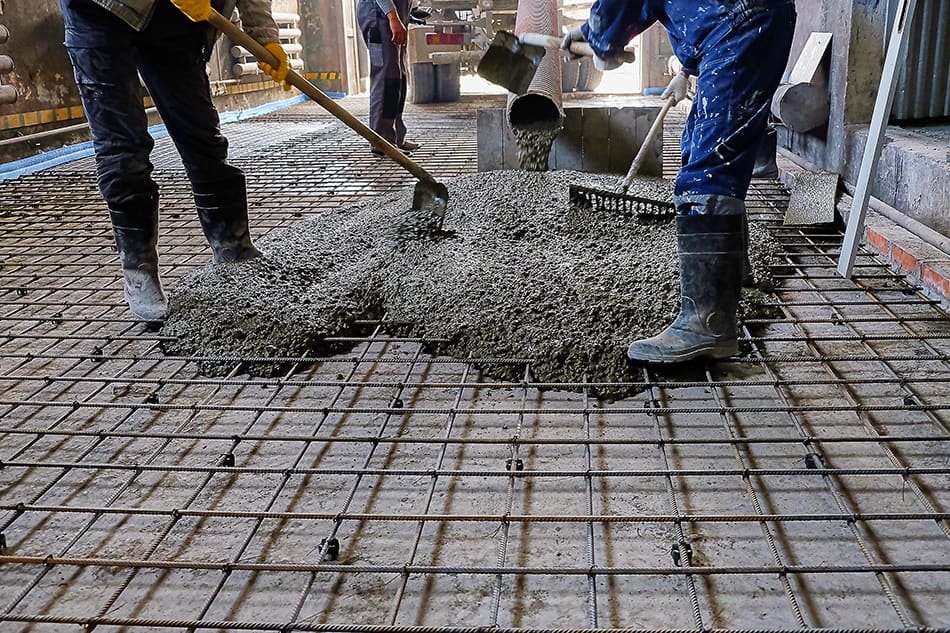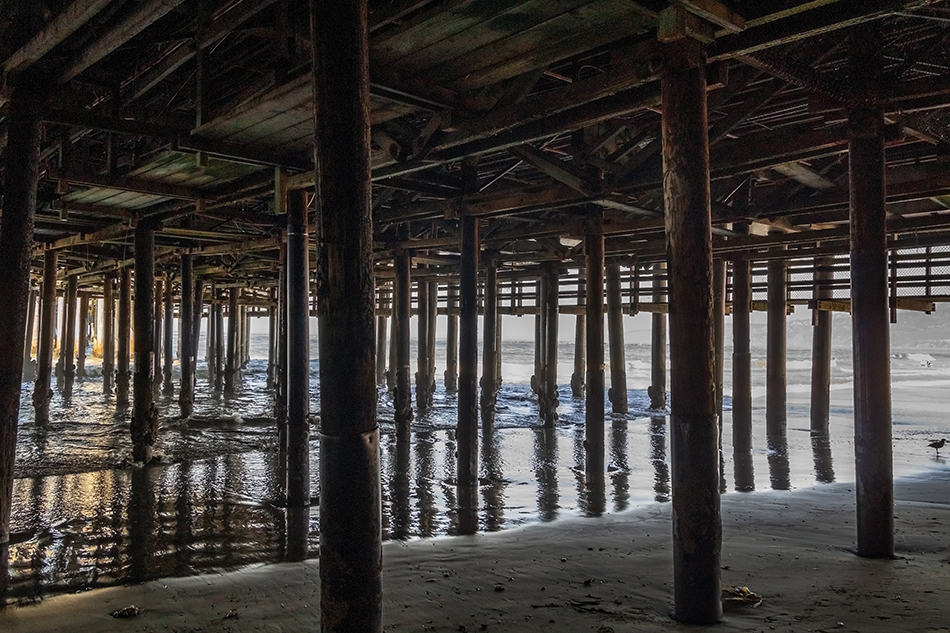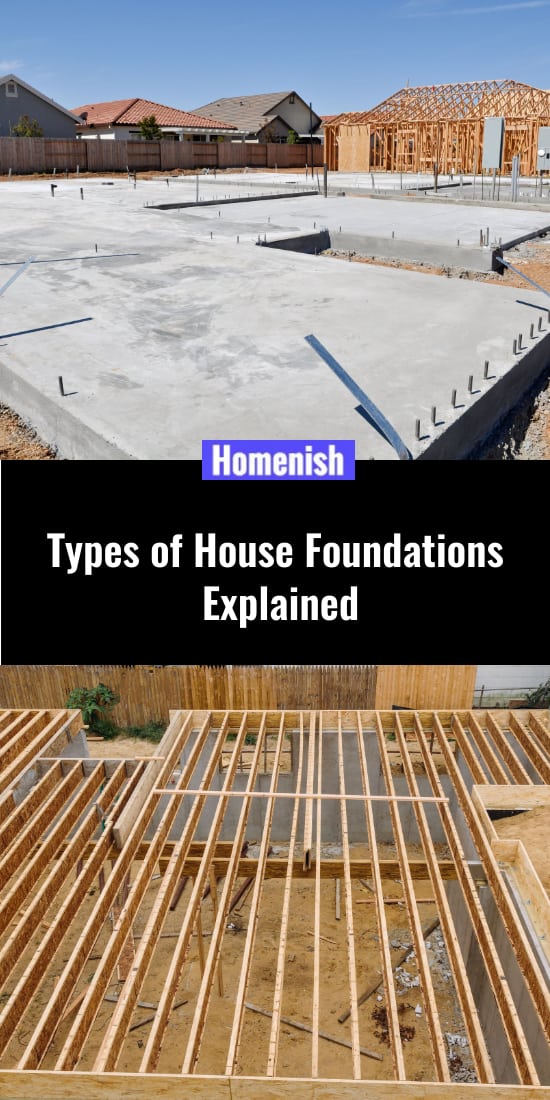Getting yourself familiar with types of house foundations might not be something you’ve ever thought necessary before, but understanding what type of house foundation you have can play a big factor in determining your home’s longevity and your level of comfort within it.
If you are looking at building your own property or you’re purchasing a new home, it is vital to get to grips with different types of house foundations. House foundations will be the backbone of your property, so it’s essential that they are appropriate not only for your own personal preference but also for your climate and for the type of ground they are built on.
Types of House Foundations
1. Basement
A basement foundation is created by excavating land underneath where the house will be built, usually to a depth of around eight feet. Concrete will be poured into footings to support the walls, and the concrete walls will then be erected.
Lastly, a concrete slab is poured in to create the floor. The key advantage of a basement foundation is that they create a lot more usable square footage in the home without extending the property’s footprint. Basements can be finished or unfinished.
A finished basement will almost double the home’s living space and will be completed to a standard much like the rest of the home, with heating or air conditioning, electricity, and decor.
An unfinished basement will be much more cost-effective when building a home because no additional services will need to be added to the basement. Most people who have unfinished basements use them as a storage space and a handy place to keep loud or unsightly appliances, such as a furnace or a tumble drier.
The benefits of keeping appliances like this in an unfinished basement are numerous. They will be out of sight and not taking up valuable space in the living areas of your home, they won’t be able to be heard when in use, and they can be easily accessed for maintenance purposes. Unfinished basement foundations also provide a great space for storing rarely used items, such as holiday decorations or sports and hobby equipment.
The disadvantages of basement foundations are that they are not suitable for all types of ground, and they can be difficult to maintain. Most types of basements have a reputation for smelling damp or having mold problems because moisture can seep through the supporting walls from the ground it is built up against.
To prevent this, you’ll need to ensure that your basement foundations are properly sealed, though many older properties were not sealed correctly, and so this is something you should investigate and address if you buy or live in an older home with a basement foundation.
The ground soil on your property may also affect whether it is suitable for building a basement foundation. If there is limestone of bedrock close to the surface of your ground, then digging it up might simply be impractical. Equally, waterlogged soils, clay soils, or wetland soils are not well suited for building basements foundations. In these instances, you would be much better advised to build a home with foundations off the ground.
There are two main types of basement foundations.
1.1. Full Basement
A full basement is completely underground, with structural walls buried in the ground on all four sides. Sometimes a small window may be present high up on a basement wall (at ground level when viewed from outside of the property), but often a full basement will have no windows at all.
1.2. Daylight Basement
A daylight basement is built on the sloped ground so that one wall of the basement foundations will be entirely underground, while the wall on the opposite side will be partially or completely above ground with full-sized windows and doors. This type of basement foundation has all of the advantages of a full basement but with more natural daylight flooding in.
If you want a daylight basement but have a level lot, you will need to do a lot of ground prepping before you can start your build. It’s not impossible to create a daylight basement foundation on a level plot of land, but it will take more work and add significant cost to your project.
2. Concrete Slab
Concrete slab foundations are the most common type of foundations for homes in North America. The way they are built can vary, but the end result is always a large, solid slab of concrete, on top of which the home is built. The concrete slab is typically between six and eight inches thick, though the depth can be thicker in certain areas where the load-bearing walls are intended to go.
These types of foundations are best suited to climates that do not experience freezing and thawing ground in the winter because these movements beneath the concrete can cause it to crack and shift. They are popular in warmer climates because they remain more stable, and they offer excellent protection against termite infestations.
Concrete slabs are the least expensive type of home foundation, which may also contribute to their popularity. They are easy and quick to build, making home construction a faster process. Concrete slab foundations require very little excavation to the land as they don’t need to go very deep. This makes them ideal for particularly rocky ground that is difficult to dig up. The main disadvantage of this type of foundation is that it does not provide any extra living space or storage space as a basement or crawlspace foundation does.
Though a basement foundation does cost more to build, this cost can be recovered when the property is sold because the added square footage will increase the value of the home. However, some people may appreciate not having space underneath their home, as this can often be an inviting space for mice and other rodents to set up a house.
Another drawback of concrete slab foundations is that the drainage lines and water pipes that supply the property will be fixed underneath the layer of concrete, so if any problems occur, it can be very difficult to access these pipes to investigate or resolve any issues.
The different types of concrete slab foundations include the following.
2.1. On-Grade
This type of concrete slab is made on-site by pouring concrete directly onto the prepared ground. The edges of the slab will be thicker, giving it the look of a downturned edge, and helping the slab to form a footing for extra stability. Rebar is usually added before the concrete sets, which will increase the strength and help prevent cracking.
2.2. Pre-Poured
This type of concrete slab is created off-site. Concrete is used to make foundation panels, which are then transported to the site and moved into place with the use of cranes. Pre-poured concrete slabs are effective but typically cost more than on-grade concrete slabs.
2.3. T-Shaped
A T-shaped concrete slab is poured onto a supportive structure that is built beneath it. First, concrete footings are installed below the frost line, and then walls are built on top of this to reach the soil’s surface. The concrete is then poured on top of this.
2.4. Frost Protected
This type of concrete slab foundation contains a type of insulation that helps to prevent the ground underneath from freezing, and thereby greatly reduces the risk of the concrete cracking.
3. Crawlspace
Crawlspaces are a type of foundation that elevates the home and leave a gap of open space beneath the property, generally just a few feet tall. The name crawl space comes from the fact that this space is so small, you typically need to crawl through it to access anything underneath.
This is a less expensive option than building a basement foundation as it requires much less excavation. Fewer materials will be needed for the foundation walls, and the build will be faster, also contributing to lower labor costs. Compared with concrete slab foundations, though, crawl spaces are a more expensive and more time-consuming option.
This type of foundation is a good choice in flood-prone regions because the home is elevated off the ground and, therefore, better defended against any rising water. A crawl space is usually not heated but may be vented to encourage extra airflow. The additional moving air beneath the floors of the home will help to keep the house cool in the summer months.
A crawlspace also provides a useful place to store some lesser used items, but be careful not to store anything down there that is valuable or susceptible to damage from weather, as these spaces are not very secure. In many homes, a furnace or heating system will be situated in the crawlspace.
This saves space in the house itself and means the system can be accessed relatively easily in the event of maintenance or repairs. Similarly, pipes and other essential utility services will be fitted in the crawlspace, so if these need attention, they can be reached without having to damage the home.
The drawback of having a crawlspace is that it can create problems with moisture, which can result in mold or damp. To combat this, many people opt for a dehumidifier to help to remove moisture from the air, but you can also install a vapor barrier or insulate the crawl space and seal it to prevent such problems from occurring. Crawlspaces are also an attractive space for pests to live.
Crawlspace foundations are typically constructed using the following methods.
3.1. Pier and Beam
This type of foundation consists of concrete footings embedded in the ground that provide support for wooden vertical piers. The piers will then be joined by horizontal beams made from concrete; on top of that, the crawlspace will be built. This type of foundation can also be made entirely from wood, though this is much less common.
The type of climate you live in can affect whether this will be a suitable option. A soil analysis will also have to be carried out before installing a pier and beam foundation to ensure it is appropriate. The best type of soil for these foundations is clay soil. Pier and beam foundations are popular in commercial buildings and industrial settings.
3.2. Footing and Stem Wall
This type of foundation is created by first digging footings at a depth of between 18 and 48 inches. They can be between 12 feet and 36 feet wide. Concrete will be poured into the footings, creating an entirely solid, continuous, and strong base. On top of this, concrete blocks are installed, known as stem walls.
These walls can vary in height, though for crawl spaces, the maximum height is usually four feet. These types of foundations are suitable for use in places with mild to moderate frost because they are very resistant to movement and provide an incredibly stable and sturdy base for a property. Footing and stem walls are also resistant to moisture issues.
Considerations for Choosing House Foundations
Climate
Understanding how a certain type of house foundation will perform in your climate is probably one of the most vital factors in selecting the right type of house foundation. Some house foundations, like a concrete slab, are incredibly strong and durable, but when installed in an inappropriate climate, they can become weak and problematic.
Areas prone to frost should avoid concrete slab foundations because when the ground underneath the concrete freezes and subsequently thaws, the movement can cause cracking of the concrete foundation. This movement will result in cracks in the walls of your homes and other unpleasant issues. A home on a cracked concrete slab will be difficult to sell and could result in a huge loss of money.
If you live in a warm climate, a concrete slab would be much more appropriate, but if you struggle to keep your home cool in summer, then you may want to consider a crawlspace foundation because these provide increased air circulation around your home that can help to keep temperatures down in warmer months.
If you live in a flood-prone area, then a type of house foundation that will elevate your home off the ground might appeal, as it will help to protect your home and your possessions from floodwater in the event that flooding occurs.
Ground Type
If you’re building a new home, then don’t get your heart set on a type of house foundation before you understand the ground you are dealing with on your building plot, as this will largely dictate what options are available to you. If you are keen on a basement foundation, then it is worth investigating what type of soil a plot of land has before you purchase it.
Very rocky soil that has limestone close to the surface can be very difficult to excavate in order to build a basement foundation, and it can become a very expensive and lengthy process to excavate it to the needed depth.
A dense soil, like clay soil, is best for basement foundations because it doesn’t allow water to drain freely and therefore can help to keep moisture away from your below-ground foundation walls. For heavy or rocky soils, a concrete slab foundation is more appropriate because this type of foundation requires very little in the way of excavation, therefore cutting down the cost and build time of your project.
Visual Appeal
When discussing house foundations, it’s usual to consider all the practicalities and functionalities they offer, while weighing up the pros and cons. You might also want to think about the look that different types of house foundations will give your property, though, as if you intend to live in your new-build home, then you’ll be looking at the property daily, and it needs to be appealing!
The visual appeal of a home will generally come down to personal preference, so research homes in your areas that you like the look of and learn about the types of foundations they have. Searching for images online can also be helpful in narrowing down the types of properties that appeal to you.
Space
Some types of house foundations can provide you with extra space, which might be something that appeals to you. A crawlspace gives you storage space underneath your home, which will help to free up space in the main portion of your property and allow you to lead a less cluttered and more organized life.
Depending on the height of your crawl space, you may have the option to install a shelving system for improved storage. Note that not everything will be suitable for storing in the crawl space. These areas can be prone to moisture problems, so ensure everything is placed in sealed plastic boxes to avoid them becoming damp. You shouldn’t store anything valuable in a crawl space because they are not especially secure.
For the most space added to your property using house foundations, a basement foundation cannot be beaten. Building a basement foundation adds an entire extra level to your home, often doubling the living space. Basements can be left unfinished to save on costs, and then used as storage spaces.
Many people opt to build a laundry room in their basement to keep the noises of washing machines and tumble driers away from the main living portions of the house and to free up space, these appliances would usually take up upstairs.
Finishing a basement will add further costs to your project, but it creates additional living areas for you to enjoy. If you are purchasing a home with an unfinished basement, renovating it to become a finished basement can be a great project to take on.
Most people with good DIY skills will be able to convert an unfinished basement to a finished basement, where you could create a recreation room for the family or some additional bedrooms. A games room or children’s playroom is also a popular way to make use of a finished basement foundation.
Expense
The cost of different types of house foundations varies drastically. If you are on a tight budget, then a concrete slab on-grade is always the least expensive option. However, you might want to consider the return on your money. While a basement foundation is typically the most expensive of all types of house foundations, it will usually result in a house that will be worth more money than a comparable house on a concrete slab or crawlspace.
This is because the extra square footage is very appealing to buyers, especially in cities where space comes at a premium. Research selling prices in the area you are building your home and how the types of foundations affect these selling prices.
It may be that a basement foundation is worth the extra cost for the return on your money that you will see if you eventually sell the property, or it may be, particularly in very rural areas, which a basement foundation won’t increase the value of the home by much at all. A crawlspace is a halfway option in terms of pricing. It is less expensive than a basement foundation, but more expensive than a slab foundation and could be a good compromise on space and cost.
Access
One of the great things about crawlspace and basement foundations is that it offers you access to the underneath of your home where service pipes run. This means that as things wear out over time and need to be replaced, you can gain access to them relatively easily.
If you have a concrete slab, this will not be the case, and you may have to dig up some of your concrete foundation in order to reach broken pipes.
Time
If you’re in a hurry to get a project built, a concrete slab poured on-site will minimize the length of time it takes to construct your home. A basement foundation takes the longest to prepare and build, so this might not be a suitable option if, for some reason, your new home needs to be ready in a hurry.
